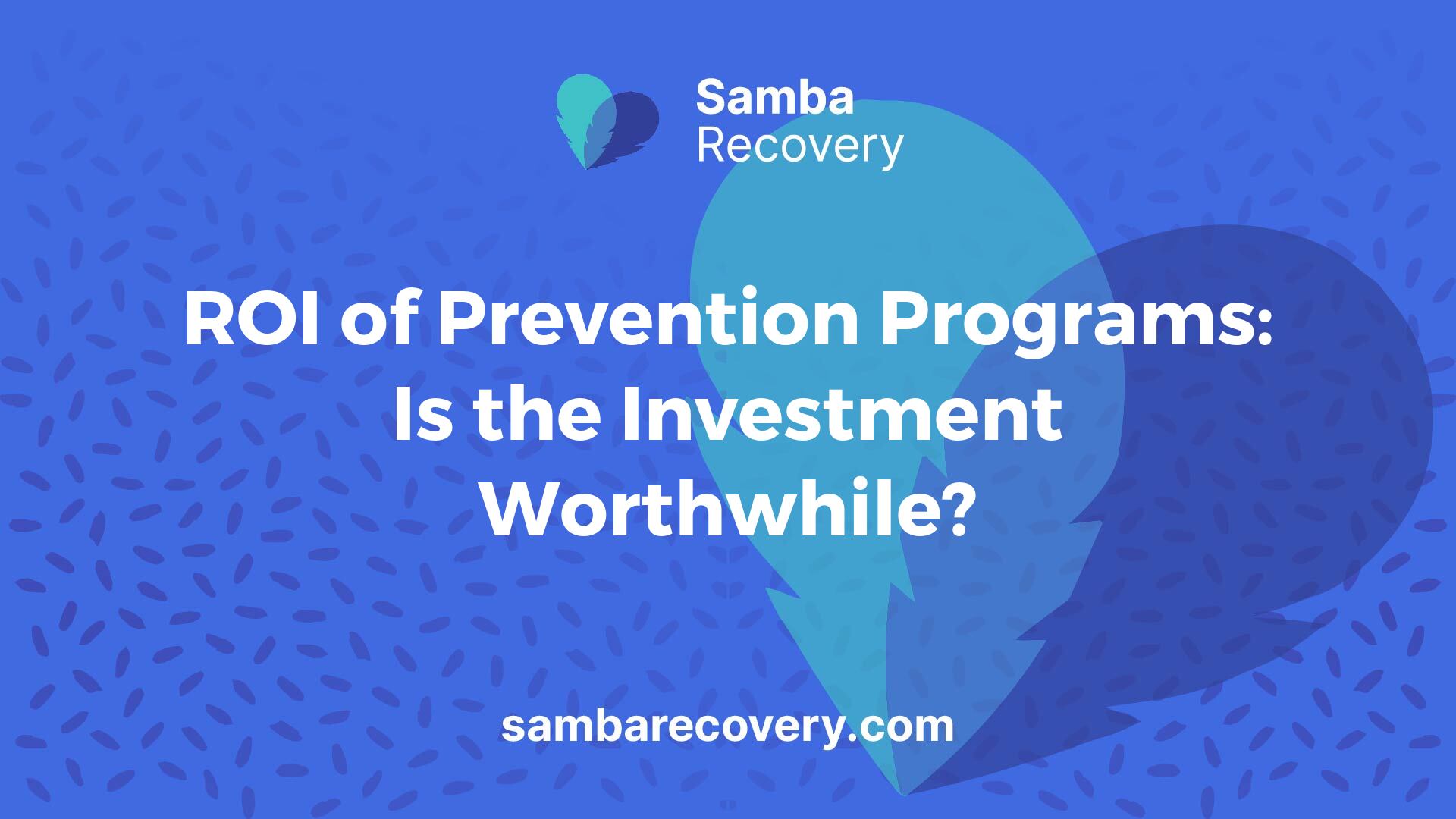Evaluating Prevention Programs
Understanding the effectiveness of prevention programs is crucial for determining their potential return on investment. This evaluation often involves two key measures: outcome measures and process measures.

Outcome Measures for Effectiveness
Outcome measures focus on the results of prevention programs. These measures help determine whether a program achieves its intended goals, such as reducing addiction rates, preventing substance abuse, or decreasing related health issues. For instance, rural suicide prevention programs typically track outcomes like reductions in the number of suicides and suicide attempts as indicators of program success.
Outcome MeasureDescriptionReduction in IncidenceDecrease in the number of new cases of addiction or related issues.Rate of RecoveryPercentage of participants who achieve long-term recovery.Behavioral ChangesChanges in specific behaviors relevant to addiction, such as substance use frequency.
Process Measures for Implementation
Process measures evaluate how well prevention programs are implemented. These measures assess the extent to which a program is delivered as intended, including participant engagement, fidelity to the program model, and overall accessibility. An effective evaluation of prevention programs considers both outcome and process measures to comprehensively assess their effectiveness.
Process MeasureDescriptionProgram ReachPercent of the target population that participated in the program.Implementation FidelityDegree to which the program follows its established protocols.Participant SatisfactionFeedback from participants regarding their experience with the program.
Success in prevention programs often relies on meeting specific criteria within both outcome and process measures. Programs with rigorous monitoring and assessment processes are likely to yield more positive results, helping stakeholders to determine whether prevention programs are a good return on investment?.
Efforts such as social marketing interventions have demonstrated potential in driving behavioral change, confirming that meticulous application of process measures can enhance effectiveness in achieving desired outcomes [2].
Cost-Benefit Analysis
Understanding Cost-Benefit Analysis
A cost-benefit analysis (CBA) is a systematic approach that compares projected costs and benefits to evaluate the feasibility of a project. The goal is to determine whether the benefits outweigh the costs, making the decision worthwhile. The process typically includes establishing an analytical framework, identifying the various costs and benefits involved, assigning dollar values to each element, and tallying the totals for both sides. This information helps in assessing the effectiveness of prevention programs, particularly in understanding if they offer a good return on investment.
Despite its comprehensive nature, CBA does not always rely on concrete numbers. Analysts may create models to assign a monetary value to intangible factors, which can significantly influence the overall evaluation.
Factors Influencing CBA Results
Several factors can impact the outcomes of a cost-benefit analysis. These include:
The interplay of these factors illustrates the importance of thorough data collection and validation before proceeding with any financial decisions. For more on the evaluation measures in health promotion, see our section on evaluating health promotion programs.
In summary, comprehensively understanding the costs, benefits, and underlying nuances of a cost-benefit analysis is essential when assessing whether prevention programs are indeed a good return on investment.
Cost Determination
In evaluating prevention programs, cost determination is a critical factor. It encompasses both financial and non-financial costs as well as the assessment of net present value (NPV). Understanding these costs helps to answer the question: are prevention programs a good return on investment?
Financial and Non-Financial Costs
Cost determination involves various types of expenses associated with a program. These can be categorized into financial costs, which are quantifiable, and non-financial costs, which are harder to measure but still important.
Financial Costs: These include both recurring and one-time expenses such as:
Non-Financial Costs: These may involve:
The total planning and implementation costs for enhanced collaborative care programs can range from $39,280 to $60,575 across various sites [5].
Cost TypeEstimated RangePlanning Costs$39,280 – $60,575Cost per Patient$154 – $544Ongoing Costs$284 – $2,328
Net Present Value Evaluation
Net present value (NPV) evaluation is a key component of cost-benefit analysis. It assists in decision-making by evaluating the profitability of an investment.
:
To calculate NPV, the following steps are typically taken:
Positive NPV indicates a worthwhile investment, suggesting that the benefits of prevention programs outweigh the costs. Conversely, a negative NPV suggests the opposite. This evaluation is essential in assessing the effectiveness and sustainability of prevention programs.
The cost per patient over a one-month period post-implementation ranged from $154 to $544, highlighting the need for continual analysis of costs versus benefits. This assessment aids stakeholders in deciding whether to proceed with specific prevention initiatives, thus directly influencing public health investment strategies.
Benefits and Challenges
When examining the return on investment for prevention programs, it is essential to differentiate between tangible and intangible benefits. Additionally, an understanding of the risks and limitations associated with cost-benefit analysis (CBA) is crucial for making informed decisions.
Tangible vs. Intangible Benefits
Tangible benefits are those that can be quantified and measured directly, often resulting in specific financial savings or gains. Examples include:
Intangible benefits, on the other hand, are more difficult to quantify but are equally important. These may include:
Understanding the full spectrum of benefits is vital when evaluating whether prevention programs are a good return on investment. Below is a comparison of tangible and intangible benefits.
Benefit TypeExamplesMeasurementTangibleReduced healthcare costs, increased productivityCost savings, revenue increaseIntangibleImproved quality of life, enhanced community cohesionSurveys, community feedback
Risks and Limitations in CBA
Cost-benefit analysis presents several risks and limitations that may affect its effectiveness in guiding decisions about prevention programs. Some of these include:
Despite these challenges, CBA remains a valuable tool for assessing the feasibility and effectiveness of prevention programs. By establishing a comprehensive framework to evaluate costs and benefits, organizations can better navigate the complexities involved in addiction prevention efforts. For further insights into substance abuse and prevention strategies, consider exploring factors influencing drug use tendencies in individuals and nidas contributions to drug rehab.
Application in Health Promotion
Evaluating Health Promotion Programs
Evaluating health promotion programs is essential for assessing their effectiveness and ensuring that they meet the needs of the populations they serve. Organizations collect data before, during, and after program implementation to track changes over time. Evaluation measures should align with the program’s focus, target audience, and available resources for achieving set goals. This includes gathering individual participant data, such as demographic information (age, gender, race/ethnicity), biological markers (height, weight, blood pressure), and health status indicators (disease, injury, disability) [6].
Key Evaluation Measures
Measure TypeDescriptionProcess MeasuresAssesses the delivery of program activities and how they adhere to established protocols.Outcome MeasuresEvaluates the impact of the program on health indicators and overall population health.
These measures help researchers and practitioners to understand both the implementation fidelity and the ultimate effects of their initiatives. For instance, in rural areas, where access to resources might be limited, employing appropriate evaluation strategies can make a difference in program success [6].
Role of Evaluation Measures
Evaluation measures play a crucial role in establishing whether health promotion initiatives provide a good return on investment. These measures are based on both the program’s activities and its goals, as well as population health indicators. This approach helps identify what works, what doesn’t, and how programs can be improved over time.
Monitoring the effectiveness of such programs often includes using established population-level measures endorsed by organizations like the National Quality Forum (NQF). These focus on high-burden health issues and seek to improve care quality while reducing overall costs. Various frameworks, such as the one provided in “New Summary Measures of Population Health and Well-Being for Implementation by Health Plans and Accountable Care Organizations,” emphasize current health, sustainability, and subjective well-being as vital components for assessment.
By integrating these approaches into evaluations, stakeholders can systematically assess the impact of health promotion strategies, ultimately addressing the question, “Are prevention programs a good return on investment?” This comprehensive understanding leads to better resource allocation and enhanced health outcomes for communities.
Preventing Extremism Programs
Assessing Violent Extremism Prevention
The assessment of programs aimed at preventing violent extremism is critical in determining their effectiveness and overall impact. Over the past decade, the National Institute of Justice (NIJ) has encouraged cross-disciplinary studies focused on understanding the outcomes of policies and initiatives designed to counter violent extremism. These assessments are essential in revealing what works, what doesn’t, and how to improve ongoing efforts in this area.
Evaluations often examine various process measures, including participant demographics, service access, retention rates, and overall satisfaction. Such data can provide insights into program implementation and how effectively these programs reach their target audiences. For instance, the evaluation of several initiatives, such as WORDE and Safe Spaces, emphasizes the importance of community engagement and resource availability in enhancing program impact.
Effectiveness of Prevention Initiatives
To evaluate the effectiveness of various prevention initiatives, qualitative and quantitative assessments are necessary. Findings from programs like the Safe Spaces Initiative indicate that many efforts have not sufficiently addressed actual community concerns, which can hinder their success. For example, this initiative faced challenges such as low buy-in from community leaders and insufficient resources, which ultimately led to declining participation levels [7].
Table 1 illustrates some common indicators used to assess the effectiveness of prevention initiatives against violent extremism:
IndicatorDescriptionCommunity EngagementLevel of participation and buy-in from local stakeholdersResource AllocationAvailability of financial and human resourcesImplementation FidelityAdherence to program design and deliveryParticipant SatisfactionFeedback from participants regarding program impact and relevanceBehavioral ChangeMeasurable shifts in attitudes or behaviors among participants
Sound evaluations help inform the development of future initiatives, ensuring they are strategically aligned with community needs. This continuous feedback loop is crucial in addressing the factors that contribute to extremism and identifying effective solutions.
Insights derived from such evaluations also play a significant role in answering the question: Are prevention programs a good return on investment? By weighing the costs against the benefits of prevention strategies, stakeholders can make informed decisions regarding future funding and resource allocation, further enhancing their effectiveness in tackling violent extremism.
References
[2]:
[3]:
[4]:
[5]:
[6]:
[7]:






